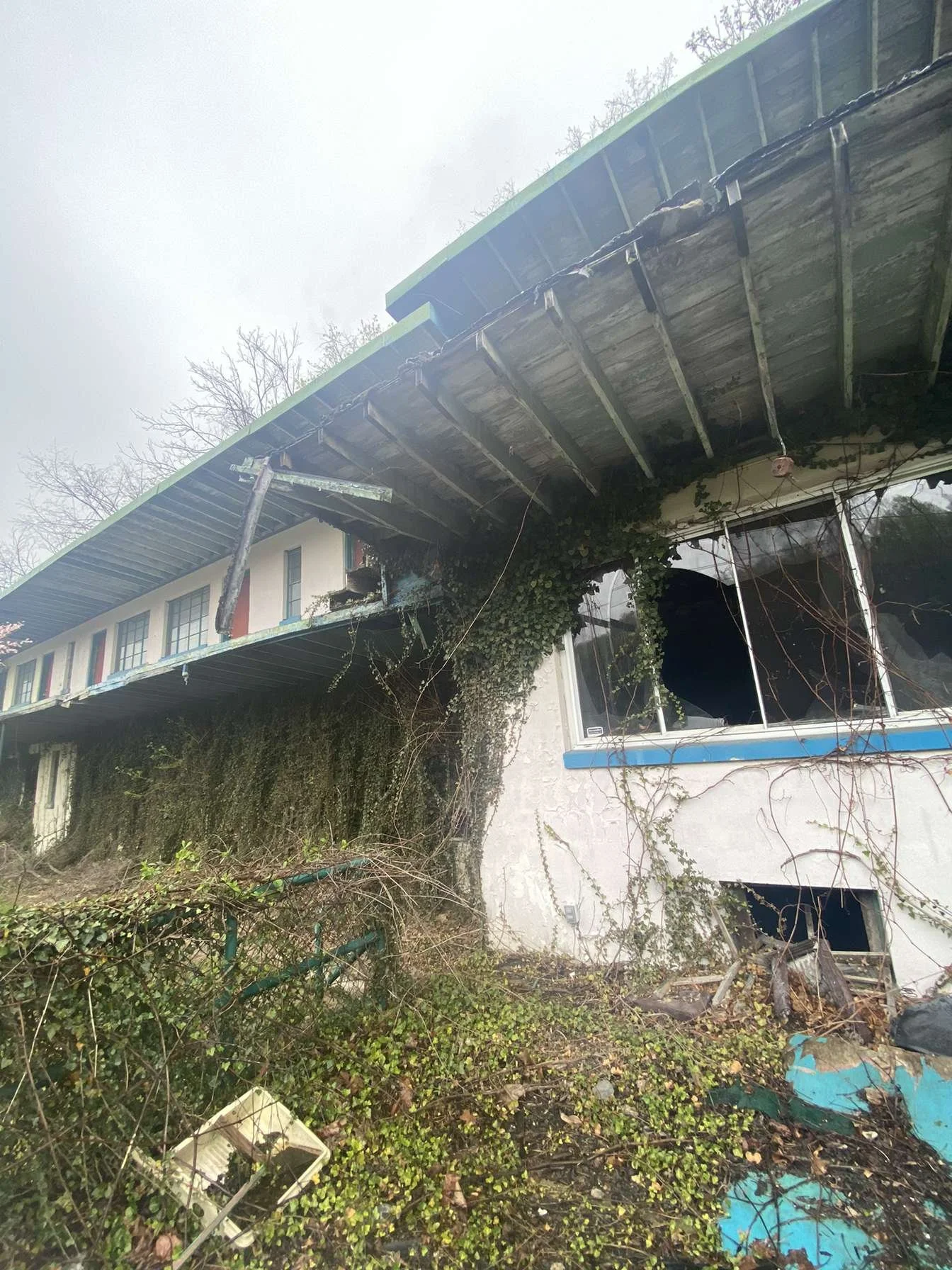Abandoned Appalachia Series

Perched along U.S. Highway 421 in Baxter, an unincorporated hamlet at the KY-72/US-421 split just north of Harlan, the Jones Motel once beckoned travelers with a neon sign, a small hillside swimming pool, and the promise of a cozy night’s rest according to several posts in the ‘I Grew Up in Harlan’ facebook group. Like many family-run roadside lodgings of its era, it wasn’t just a business — it was a way of life. Over the decades, the Jones Motel transitioned from a lively hub serving home-cooked meals and cheap gas to a forgotten shell of mid-century Americana. Join me as we unravel the story of this once-thriving landmark, now a forlorn relic of Appalachian travel history.
Origins and Early Years (1940s)
The Jones Motel opened as part of a modest roadside complex in the very late 1940s or early ’50s—postcards dated 1952 are the oldest located so far. Matt Jones, noted on vintage postcards as the owner-operator, originally built a two-story motor court alongside a small restaurant and service station. Travel guides of the era praised the motel for being “clean” and “handy,” pointing out how Matt Jones took pride in keeping the place in tip-top shape. Such endorsements were prized at a time when the comfort and integrity of a roadside stop mattered as much as its neon sign.

Mid-Century Heyday and Features
In the 1950s and early ’60s, the Jones Motel thrived in step with America’s booming car culture. Travelers could grab a bite at the on-site restaurant, fill their tanks at the Texaco (later Sinclair) pumps, and settle in for a restful night at one of the motel’s units — all without leaving the property. Vintage postcards published by local printer Glenn Durham captured its timeless motor-court appeal: a long two-story building tucked against a lush hillside, classic cars lined up out front, and a gleaming neon “JONES MOTEL” sign lighting the way. Some local folks even recall a swimming pool in the back, catering to a growing post-war appetite for “resort” amenities among passing families.
Later Years: Decline in Travel and Changes (1960s–1980s)
By the late 1960s, the landscape of travel had changed dramatically. Newer lodging options, evolving highway routes, and the general ebb and flow of coal country prosperity all took their toll on the Jones Motel. One key setback came in the form of severe flooding — local accounts note that a major flood in the late 1970s battered Harlan’s infrastructure, further discouraging would-be travelers. The gas pumps at the motel disappeared first, and the once-busy restaurant ceased regular service soon thereafter. One visitor in the early ’70s recalled having to make do with Vienna sausages and potted meat from a can because there was no on-site dining available.
Still, the Jones Motel remained under the Jones family name — some family oral history indicates the motel was later tied to Matt Jones’s daughter Joyce and her husband Ben Abraham — well into the 1980s. Even as casual travelers thinned out, it remained a steady, if fading, entry in local phone listings. By then, most of its clientele were long-term boarders or coal workers rather than tourists, reflecting the broader downturn in Harlan’s once-thriving travel scene.

Closure and Abandonment (1990s–2010s)
By the early 2000s, the Jones Motel had run its course. Business finally dwindled to nothing, and the establishment closed its doors. Attempts to sell the property in the 2010s proved fruitless, and time took over. Vines and shrubs tangled around the once-bright façade, while vandalism and trespassing — perhaps fueled by curiosity — left the motel battered by more than just the elements. Where guests once rested, broken windows and crumbling drywall remained, covered in hastily scrawled warnings: “Danger” and “No Trespassing.” Despite years of neglect, the property still stood in the late 2010s, a shadow of its former self and a bleak reminder of the region’s changing fortunes.
Cultural Significance and Legacy
For many locals, the Jones Motel wasn’t just a place to hang your hat for the night — it was a social anchor. Families stopped in for Sunday dinners when the restaurant was open, while out-of-town visitors brought fresh faces and extra dollars to Harlan’s economy. The motel’s neon sign and widely circulated postcards helped engrain its image into the county’s collective memory. Today, these souvenirs fetch nostalgia-fueled interest on online auction sites, and older residents still share stories of poolside summers or random encounters with strangers on cross-country journeys.
In recent years, the abandoned Jones Motel has drawn “urban explorers” documenting its decline in photographs and videos. While the decaying walls may look eerie to some, to others they are a monument to Harlan’s mid-century prosperity. Each memory — be it a cherished postcard or an old-timer’s recollection — helps keep alive the motel’s role in the broader tapestry of Kentucky’s roadside Americana.

Preserving the Memory
Though the Jones Motel now stands silent, its story remains part of local lore. If you have photos, postcards, or personal anecdotes, consider sharing them with local history groups or online forums. These fragments of the past help us piece together the cultural heartbeat of Harlan County and preserve the motel’s place in Appalachian history.
Sources & Further Reading
Historical postcards and travel guides (Duncan Hines directory, Glenn Durham postcards)
Dead Motels USA blog/Instagram posts
Vintage postcard listings and eBay/PicClick archives
Personal accounts in local Facebook forums
Contemporary documentation from YouTube and photo blogs
(Note: All references are cited in condensed form for readability; see original documentation and agency records for in-depth coverage.)
Author’s Note: This piece is part of the Abandoned Appalachia series, an ongoing exploration of once-thriving communities across the region — places where generations found work, camaraderie, and identity, only to see it all fade as energy markets plummeted, times shifted, and mines went dark. Follow along for more stories of resilience, reinvention, and the powerful lessons these hills still hold.